From the March 2022 issue of Apollo. Preview and subscribe here.
In May 2020, the sculptor Charles Ray was driving north from his home in Los Angeles to Anacortes, in Washington state, to see a man about a boat. Locked up in the early months of the pandemic, the restless Ray got what he calls ‘Covid fever’ and, despite the entreaties of his wife Sylvia, threw a sleeping bag into the back of his car and set off for the boatyard, near the Canadian border, where he needed to make some decisions about the layout of a sailing boat that was being built for him. Ray takes sailing very seriously indeed. In 2003 he was nearly shipwrecked in the Pacific Ocean when an unlit military vessel collided with him in the middle of the night; this new boat, he tells me, is designed to accommodate his wife and her friends so Ray will not have to sail alone.
Somewhere past Sacramento, Ray lost control of his car – he thinks he might have had a minor stroke or fallen asleep – and left the freeway at 75 miles per hour. His car rolled to the bottom of a ravine. He remembers extricating himself from his seat and sliding down the roof of the car while onlookers yelled down to ask if he was all right. He broke so many bones, he tells me – including, most seriously, his neck – that it took doctors five weeks to notice that his elbow was broken, too.
At the time of his accident, fabricators were already working on his sculpture Unbaled Truck, which looks at first glance like it has rolled into a ravine and remained there for many years. On a sustained close inspection – something all of Ray’s sculptures demand and reward – it becomes clear that this is not a wreck but a resurrection. Followers of Ray’s work may recall his sculpture Baled Truck (2014), for which he had his 1948 Chevy pick-up crushed into a neat three-metre oblong then digitally scanned and milled from solid stainless steel into a gleaming 13-tonne monolith. Sometime later, Ray had the idea to pull the crushed truck back into shape. It took a team of fabricators nearly three years to uncrumple it with a hydraulic winch, then stabilise the delicate bodywork and rusted paintwork so it would not disintegrate when it travelled.
Unbaled Truck was recently shipped from the Los Angeles workshop of his long-time fabricator Mark Rossi to the Bourse de Commerce–Pinault Collection in Paris, where one half of Ray’s retrospective opened in February (until 6 June). Co-produced by the Centre Pompidou, which hosts the other half, the two-part exhibition concludes an unintentionally busy season for Ray, whose career survey, ‘Figure Ground’, opened at the Metropolitan Museum of Art, New York, in January (until 5 June), while the third of a series of solo exhibitions at the Glenstone museum in Maryland opened in early December.
Unbaled Truck, Ray explains, began as a ‘thought experiment in reverse causality’ – an experiment that became more personal with his accident. Time, for Ray, is at once a philosophical preoccupation, a sculptural ingredient and an artistic theme. Most of his sculptures take years to make, often going through several manifestations in different media before he allows them to leave his studio. (Or rather studios – he has several, dedicated to different media, as well as outsourcing production of certain pieces to specialist workshops.) The genesis of Unbaled Truck might even be traced back to Unpainted Sculpture (1997), a fibreglass recreation of a wrecked car, painted a flat pale grey – but, like all of Ray’s work, it is as porous to the events of the artist’s life as it is to currents in contemporary culture. His sculptures, Ray likes to say, all start somewhere, but they don’t stay there. Unpainted Sculpture isn’t about the death of the car’s driver, just as it isn’t about the history of Pontiac car production in Detroit. ‘The whole car has transformed itself in its materiality,’ he says. To me, it seems these sculptures are foremost about the material and symbolic act of their transformation.
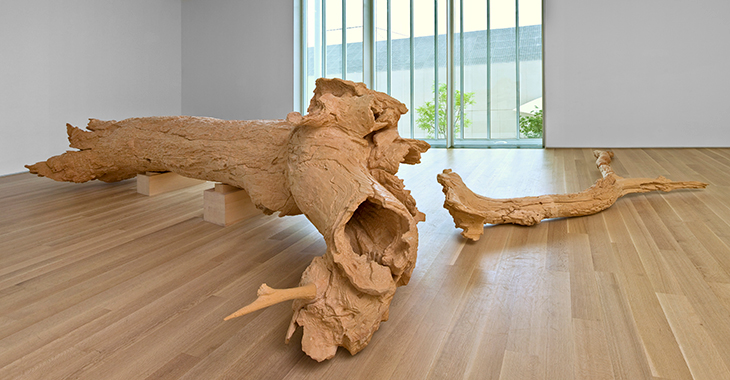
Hinoki (2007), Charles Ray. Art Institute of Chicago. © Charles Ray
Ray often talks about the Greek concept of pneuma – the animating breath that fills a body (or a sculpture) with what might also be understood as a soul. Unbaled Truck, which recalls a crumpled paper bag blown up with air, is imbued with pneuma, as are many other of Ray’s sculptures. Hinoki (2007) – a half-rotten tree trunk, rescued from a field by the artist and laboriously remade by Japanese woodcarvers into solid cypress – was first imagined by Ray as a life-sized vinyl inflatable. (Fabricators told him there would be too many seams.)
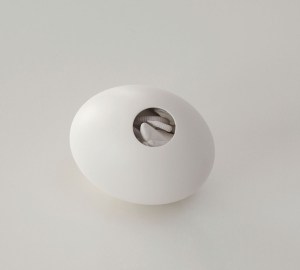
Chicken (2007), Charles Ray. Glenstone Museum, Potomac, Maryland. © Charles Ray
‘I’m interested in the structural dynamic of the soul. Is there a soul?’ Ray wonders. The tiny white sculpture Chicken (2007) is a life-sized egg with a perfectly round hole through which can be seen the beak and claws of an embryonic bird. The chick is not pecking its way out; instead, we have bored through the shell with our eyes, willing it into life. Companion pieces – Handheld Bird (2006) and Hand Holding Egg (2007) – also gesture towards the possibility of pneuma without ever quite claiming it. In the porcelain Hand Holding Egg, the egg is pecked naturalistically but the hand is sliced cleanly at the forearm, revealing its shell-like hollowness. Handheld Bird, made from white-painted steel, shows the chick still curled up, its shell disappeared. If these are depictions of life, they are simultaneously depictions of its opposite: if not death, then the absence of life. They are only sculptures, and Ray never lets us forget it.
Since the early 1970s Ray, who is now 68, has pursued an intensely focused exploration of the historical and contemporary field of sculpture. Many of his early works were hybrids of sculpture and performance, in which he inserted his own body as a sculptural element. In Shelf (1981), for example, Ray stood naked, with his head inserted through a high shelf. To match the various items on the shelf, Ray’s head was painted a uniform grey. A decade later he made a self-portrait, No (1992), a photograph of a lifelike but disconcertingly lifeless mannequin that Ray commissioned then dressed in his own glasses and shirt. His artworks featuring mannequins brought him acclaim as well as notoriety – especially his installation Oh! Charley, Charley, Charley… (1992), an orgy of eight identical naked (and anatomically complete) mannequins, likenesses of the artist, blankly and joylessly pleasuring each other.
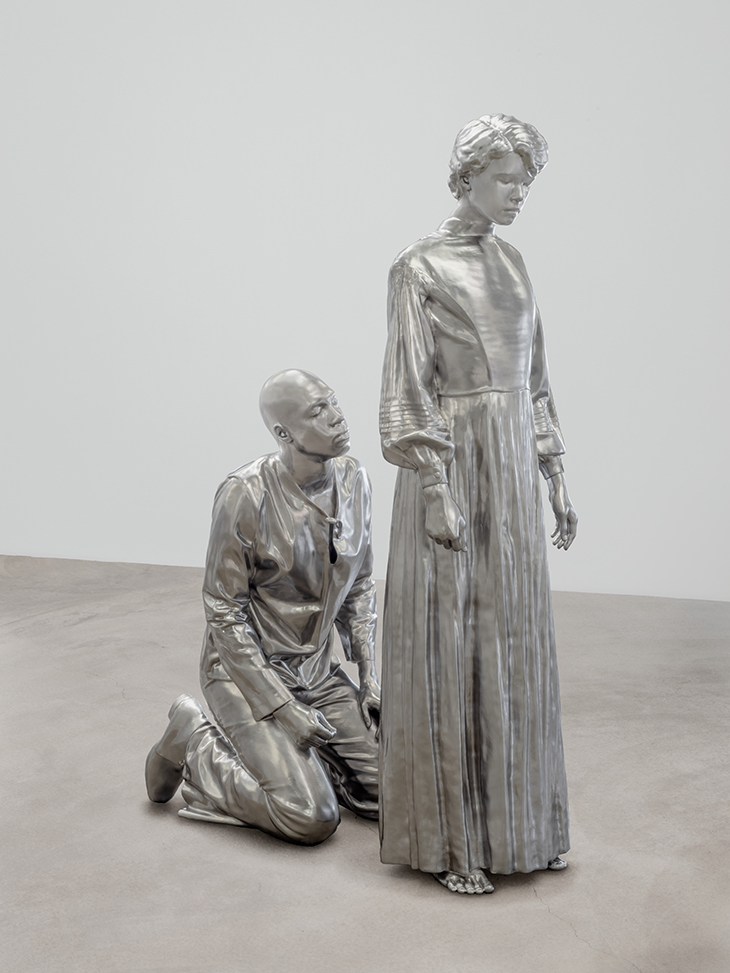
Sarah Williams (2021), Charles Ray. Collection of the artist. Photo: Charles Ray Studio; courtesy Matthew Marks Gallery; © Charles Ray
When I visit Ray, at the end of December, at his studio in Santa Monica, California, he shows me a stainless-steel sculpture titled Sarah Williams (2021). It is a follow up to Huck and Jim (2014), a sculpture that first caused a stir when the Whitney Museum of American Art in New York, which had commissioned it, declined to install it as planned in a plaza outside the museum. Huck and Jim depicts the protagonists of Mark Twain’s novel The Adventures of Huckleberry Finn (1884), with an adult Jim – the runaway Black slave – standing over a crouching, white, teenaged Huck. Both are naked. The sexual and racial overtones of the work were too much for the Whitney, or, rather, they were imagined to be too much for passing members of the public. In the years since, the subject of race, especially in relation to the history of slavery in the United States, has grown only more intense. Which might make it all the more surprising that Ray has chosen to revisit Twain’s famously divisive work for this new sculpture, which is included alongside Huck and Jim in the exhibition at the Met.
Viewers encountering Sarah Williams might not, at first, recognise the subjects. A little larger than life-size, a bald-headed man kneels behind a tall woman in a long dress. Except this is not a woman; this is Huck, depicted at the point in the story when Jim helps him disguise himself as a girl so that he can sneak into the local town and find out what the residents are saying about him. Sarah Williams is the name Huck gives when questioned. This sculpture, the title tells us, is pretending to be something it is not.
Sarah Williams is not about transvestism, or cross-dressing (which Ray considers to be a separate activity), or race, or sex. Ray does not deny they are there, however. Ask him why he is so drawn to The Adventures of Huckleberry Finn and he might rhapsodise about Twain’s evocation of time and space in the novel, ‘the steamboats belching sparks, hitting into the firmament then falling into the water’, as he puts it, the boys using the lighting and extinguishing of candles in windows of distant homes as their clock, and their odyssey down the ever-changing Mississippi River to New Orleans and back again. Sarah Williams isn’t really about any of that either, but for Ray it was a starting point.
Ray can seem almost perversely concerned with formal details and material processes, sometimes at the apparent expense of his work’s obviously allusive content. His response to controversy, which has occasionally accompanied the exhibition of his work, is often to redirect attention towards easily overlooked aspects which, to him, feel all-consuming but to others might seem entirely peripheral. Ray tells me that Oh! Charley, Charley, Charley…, for instance, is his attempt to make a multi-figure sculpture to equal Auguste Rodin’s The Burghers of Calais (1884–89). In any case, Ray believes the first thing to fall away from an artwork, in time, is the artist’s intention. Next is authorship.
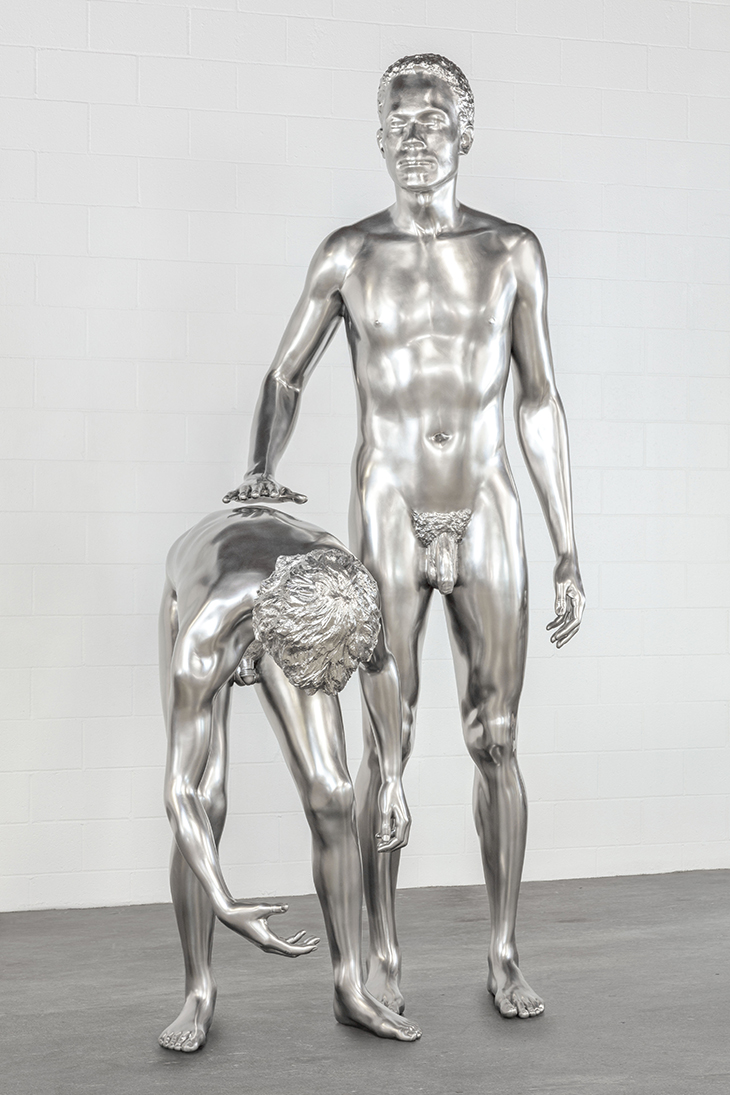
Huck and Jim (2014), Charles Ray. Collection of Lisa and Steven Tananbaum. Photo: Josh White; courtesy Matthew Marks Gallery; © Charles Ray
Looking at Sarah Williams, Ray draws my attention to the void inside Jim’s sleeve and the tension between the fish hook in Jim’s hand and the stitching in the back of Huck’s dress. Huck and Jim is similarly organised around the gap between Jim’s hovering hand and Huck’s naked back, just an inch or two beneath it. Ray calls this a ‘spacer’ and pulls out a book to show me a photo of a tabletop sculpture by Anthony Caro – an artist he reveres – in which two sections of pipe are welded together by a store-bought drawer handle. The empty space in his own sculptures, Ray says, is like Caro’s handle connecting two abstractions: ‘a cultural spacer, locking these two elements together’.
Today, it feels counterintuitive, not to mention oblivious, to talk of representations of figures so culturally freighted as Huck and Jim as ‘abstractions’. That is what they are, however, and that is why Ray is interested in them. ‘In the bigger picture,’ Ray says, ‘my sculptures don’t represent anybody or anything. They’re not depictions.’ Nor are they portraits – even when the subject is someone Ray knows well, or has specifically chosen for a role. Young Man (2012) – which took several tortured years and myriad incarnations to resolve into what Ray considers one of his finest works – was based on a former student, while Aluminum Girl (2003) is modelled on an ex-lover. Return to the One (2020) – a pulped-paper sculpture of a seated Ray included in his exhibition at the Bourse de Commerce – is not a self-portrait, and neither is Horse and Rider (2014), currently installed outside the building’s entrance. (‘It’s a sculpture of monument,’ Ray ventures.) Portrait of the Artist’s Mother (2021), a large masturbating female nude, also made from paper, is definitely not Ray’s mother.
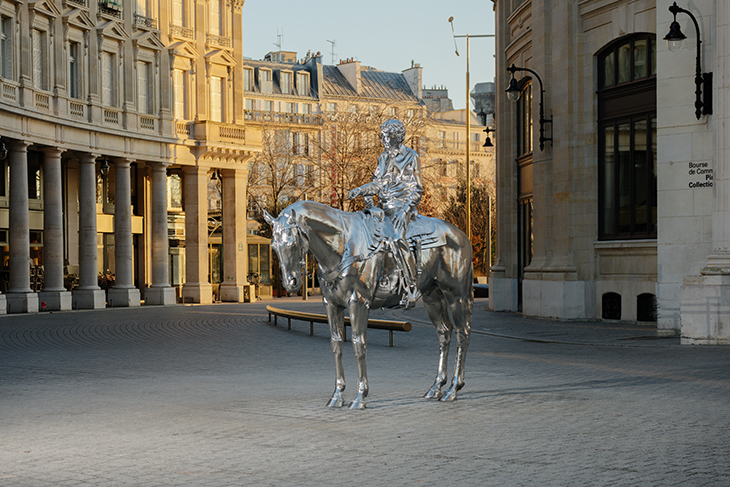
Horse and Rider (2014), installed outside the Bourse de Commerce-Pinault Collection in Paris. Photo: Aurélien Mole; © Charles Ray
Ray strives in his work, above all else, for what he terms ‘consistency’. He recalls seeing, one night many years ago, a Porsche parked on the street outside an upscale restaurant where he had just dined. He was struck by the car’s consistency as ‘a complete cultural object’ – a quality that ran from the car’s design and engineering to the street it was parked on through to the owner, presumably dining inside. Ray didn’t want a Porsche, he explains, but he wanted that consistency.
Sometimes, he goes to extraordinary lengths to find it. For Jeff (2021), he asked one of his assistants to volunteer at a needle-exchange programme for nine months to find three volunteer models who ‘looked schizophrenic’. He had in mind a three-part sculpture based on psychologist Milton Rokeach’s book The Three Christs of Ypsilanti (1964) about an experiment with three delusional men who all thought they were Jesus. The piece, which was originally intended for a deconsecrated chapel in Italy, evolved until only one figure remained.
For years, Ray struggled with his life-sized sculpture of the addict Jeff seated dejectedly on a box. One day he identified the problem. ‘Your empathy just over-ran the object, your pity enveloped it,’ he tells me. ‘The sculpture had no relationship to you; you only had a relationship to the sculpture.’ As a consequence, the sculpture ‘remained a depiction; it remained a portrait’. By scaling up the figure by about 50 per cent, he found, ‘the sculpture could fight back’ and the portrait of Jeff became a sculpture by Ray.
Although he is interested in the philosophical field of object-oriented ontology, and is on friendly terms with its founder, Graham Harman, Ray rejects the animistic notion of an object having a subjecthood or perspective. ‘The sculpture doesn’t think, the sculpture doesn’t hurt, the sculpture doesn’t get hot,’ he says. This applies also to the non-human collaborators with whom Ray has worked in recent years – the large machine tools capable of milling materials from foam to solid steel or stone, following digital files created by 3D-scanning another object, such as a crushed truck, for example, or a maquette in clay or plaster. Jeff was milled from a block of white marble; an early version was ruined when the robotic arm malfunctioned and ploughed its bit into Jeff’s side.
‘Does the machine think?’ Ray asks. ‘No! Does it need to think? No! It’s cultural. Turn yourself inside out, machines will spill out of you!’ he cries. ‘They’re not separate from us. They physically are us, in a sense. We made them, but we didn’t make them. You can’t start pulling it apart!’

A copy of ten marble fragments of the Great Eleusinian Relief (2017), Charles Ray. Collection of Joshua and Filipa Fink, New York. Photo: Ron Amstutz; courtesy Matthew Marks Gallery; © Charles Ray
Ray’s thinking is full of things one can’t pull apart: machine and human; culture and nature; history and the present; accident and intention; the secular and the divine; physicality and thought. Such complexity, such irresolvability, is what compels him to expend untold hours and resources on his work in the hopes that it will eventually ‘tumble into time’. He mentions the early Greek kouros figure at the Metropolitan Museum, a sculpture he has spoken and written about more than once: ‘It reverberates into the mind or soul of a contemporary viewer, so it’s a contemporary piece of sculpture, not an ancient piece of sculpture.’ Ray aims for his own work to do the same. In A Copy of Ten Marble Fragments of the Great Eleusinian Relief (2017), Ray remade another of his favourite artefacts from the Met: several broken pieces of a Roman copy of a Greek relief, set into a plaster cast of the Greek original. Ray’s copy, machined robotically from a slab of solid aluminium, telegraphs backwards and forwards through time.
One of the most astonishing new sculptures in Paris is Study After Algardi (2021), a 3.5m-high crucified Christ, based on a small bronze cast by Alessandro Algardi from c. 1646. Ray was brought up Catholic, but professes to no religious belief; nevertheless, Christian iconography has increasingly featured in recent work, including the fibreglass Doubting Thomas and the carved-cypress Archangel (both 2021). Study After Algardi, which is constructed from a white paper-pulp shell, feels both confounding and miraculous. Miraculous because of its imposing physical presence and textural softness; confounding because of the opacity of Ray’s intentions.
Ray likens his sculpture to Caro’s red metal Early One Morning (1962), which he says ‘is so structurally extended that if it were an inch longer it would bow or fall apart’. Study After Algardi, he says, is the same: ‘Its scale is what lets it trip into the divine.’ He uses the term ‘divine’ not in a literal sense, he hastens to add. This is not about religious belief. He believes in something else – in Algardi’s sculpture, perhaps, in the power of an object four centuries old to vibrate with contradictory ideas of death and life, the soul and the body, which are mysterious and compelling still today. He believes in sculpture.
‘Charles Ray: Figure Ground’ is at the Metropolitan Museum of Art, New York, until 5 June. ‘Charles Ray’ is at the Bourse de Commerce–Pinault Collection, Paris, until 6 June, and the Centre Pompidou, Paris until 20 June.
From the March 2022 issue of Apollo. Preview and subscribe here.
Unlimited access from just $16 every 3 months
Subscribe to get unlimited and exclusive access to the top art stories, interviews and exhibition reviews.

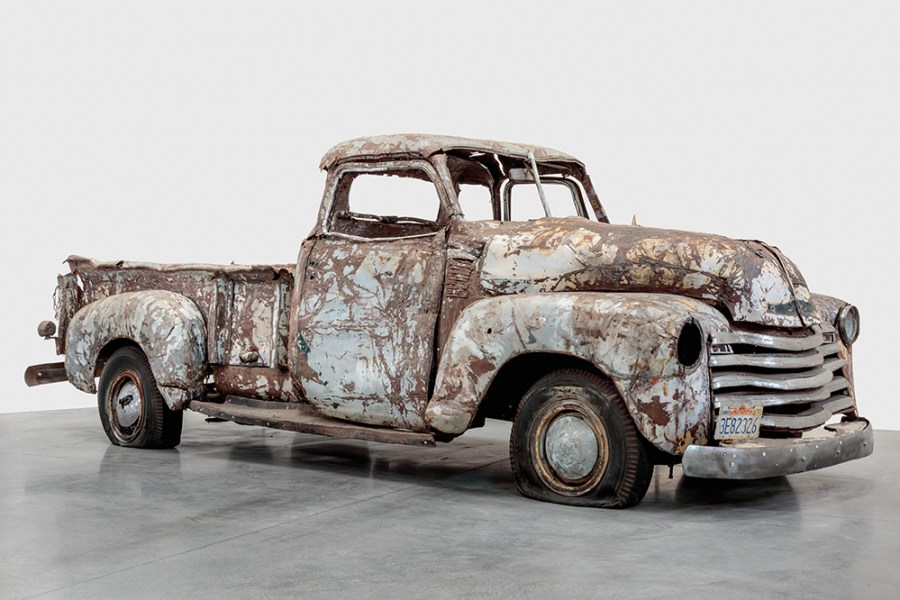
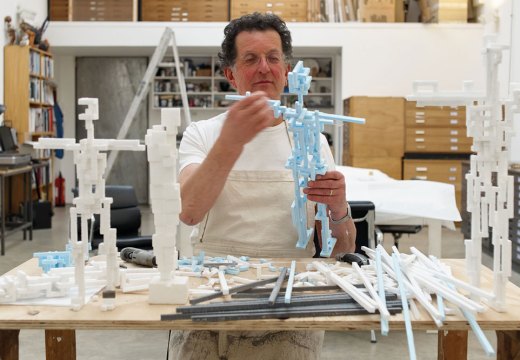
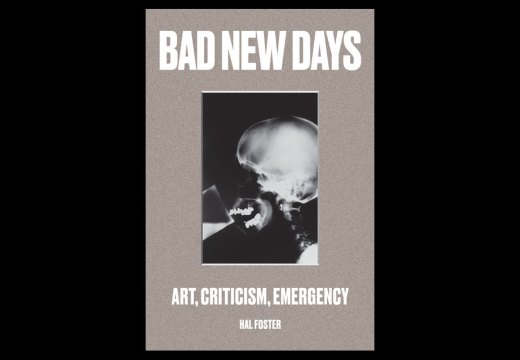
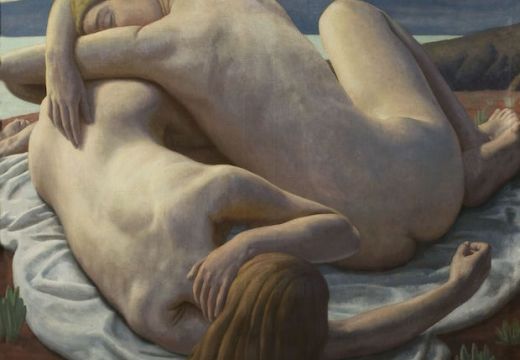









![Masterpiece [Re]discovery 2022. Photo: Ben Fisher Photography, courtesy of Masterpiece London](http://www.apollo-magazine.com/wp-content/uploads/2022/07/MPL2022_4263.jpg)
It’s time for the government of London to return to its rightful home